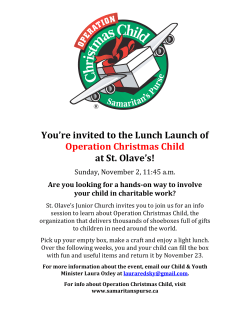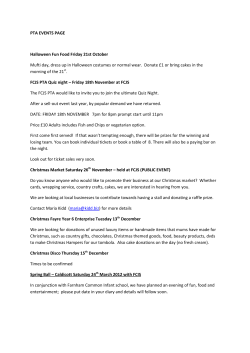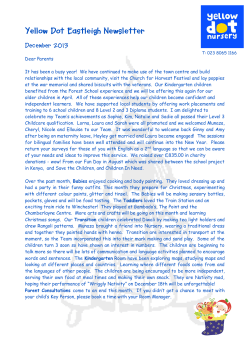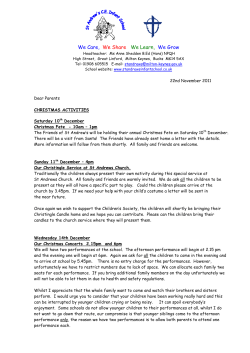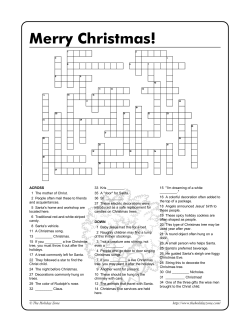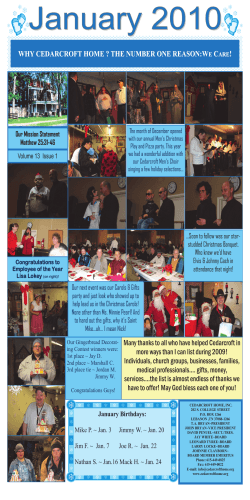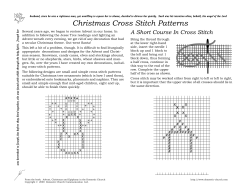
The Gift Bringer The many faces of Santa… Customs of each country…
The Gift Bringer The many faces of Santa… Customs of each country… By Lee-Anne Governess Australia www.governessaustralia.com This powerpoint is designed to give supervisors and home tutors across Australia information which has been researched and cross referenced. Like all learning it is up to you how much information you give to your children. This powerpointis part of a Christmas Info series designed by Governess Australia: Christmas Carols, Father Christmas and Christmas Info I intend to research and refined the information every year and the christmas info will be available on in the Schoolhouse from January 2009 and emailed to Outback Govies yahoo group each year. Any feedback or updated information you have on this series please email [email protected] Learning Guide This slide is a work in progress. Any information that I could add please email [email protected] Who is Santa Claus? Santa Claus, legendary bringer of gifts at Christmas. He is generally depicted as a fat, jolly man with a white beard, dressed in a red suit trimmed with white, and driving a sleigh full of toys drawn through the air by eight reindeer. Santa is said to visit on Christmas Eve, entering houses through the chimney to leave presents under the Christmas tree and in the stockings of all good children. Although this familiar image of Santa Claus is a North American invention of the 19th century, it has ancient European roots and continues to influence the celebration of Christmas throughout the world. SANTA : 1823 to NOW In 1823, Clement C. Moore wrote "A Visit from St. Nicholas', which showed Santa Claus driving a sleight drawn by "eight tiny reindeer" and in doing so he created an image we all have today. Thomas Nast drew Santa Claus based on Moore's description cementing in this image. Thomas Nast was the first artist to draw Santa Claus as a fat, jolly, white-whiskered old man. He was born September 27, 1840 in Landau, Baden, Germany and died December 7, 1902 in Guayaquil, Ecuador. He was an American cartoonist after arriving in the United States at the age of six. He was a political cartoonist who happened to create one of the most popular images of Santa Claus. He is also noted for popularizing the Democratic party's donkey. Before Santa…Saint Nicholas The accounts of his life are confused and historically unconfirmed. Saint Nicholas is the immediate forebear of the North American Santa Claus. According to legend, he makes his rounds on December 5, Saint Nicholas's Eve. Saint Nicholas, lived 4th century, before Christianity was a main religion. continues… Nicholas Saint Nicholas is the patron saint of just about everything. He is the national saint of Russia and Greece and churches named after him number in the thousands - more than 400 in Great Britain alone. He is the patron saint of judges, murderers, pawnbrokers, thieves, merchants, paupers, scholars, sailors, bakers, travelers, maidens and poor children. He is known as the friend and protector of all those in trouble. His legend spread throughout Europe, emphasizing his role as a traditional bringer of gifts. continues… Nicholas Saint Nicholas was born in the Middle East about 350 miles northwest of Bethlehem in the fourth century. (Born about 245 AD and died about 350 AD) He grew up to become the bishop of Myra (now Kale), his hometown, Lycia, near the coast of what is now Turkey. Legends tell of his love for children, his kindness and the miracles he brought about. Bishop Nicholas & the 3 sisters Perhaps the most famous story of all tells how he helped three unfortunate young sisters who all had suitors but had no dowries because their father, a poor nobleman, could not raise the money. So they could not marry. Now the bishop Nicholas was a shy man and did not like to give money directly , so he thought of a way to give it anonymously. When the first daughter was ready to marry, the good bishop tossed a bag of gold into the house at night. Later, when the second daughter prepared to marry, she too received a mysterious bag of gold. When the third daughter prepared to marry, the poor nobleman was determined to find out who had been so generous. So he kept watch and saw the bishop drop another bag of gold into the house. It has been said that Saint Nicholas climbed on the roof and dropped the third bag of gold down the chimney where it landed in a stocking hung to dry, giving us a reason to hang up Christmas stockings today. When the father saw what had happened, Nicholas begged him to keep the secret, but, of course, the news got out. From then on, whenever anyone received an unexpected gift, they thanked Nicholas. Bishop to Saint Nicholas Six hundred years later, the Russian Emperor Vladimir visited Constantinople and heard all the wonderful stories about Bishop Nicholas and decided to make him the patron saint of Russia. The stories even spread to the Laplands - to the people of the reindeer sleds. The three bags of gold Nicholas gave the sisters made him the focus of merchants in northern Italy. Statutes and pictures had shown him holding the three bags and when taken as the patron saint of the merchants, the bags became gold balls, representing money lenders and today, pawnbrokers. The anniversary of Nicholas' death, December 6th, either 345 A.D. or 352 A.D., is so close to Christmas that, in many countries, the two merged. But in Germany and the Netherlands, the two remain separate. The Sidekick : Black Peter Nicholas was sometimes said to ride through the sky on a horse. He was depicted wearing a bishop's robes and was said to be accompanied at times by Black Peter, an elf whose job was to whip the naughty children. St. Nicolas dropped… After the restructuring of christianity, German Protestants encouraged worship of the Christkindl (Christ child) as a gift giver on his own feast day, December 25. When the Nicholas tradition prevailed, it became attached to Christmas itself. Because the saint's life is so unreliably documented, Pope Paul VI ordered the feast of Saint Nicholas dropped from the official Roman Catholic calendar in 1969. Other Names for St Nick… The Christian figure of Saint Nicholas replaced or incorporated various early pagan gift-giving figures such as – Roman: Befana – Scandinavia : Julenisse – German: Berchta and Knecht Ruprecht. The saint was called Sankt Nikolaus in Germany and Sanct Herr Nicholaas or Sinter Klaas in Holland. The term Christkindl evolved to Kriss Kringle, another nickname for Santa Claus. Christmas celebrations around the world It is interesting to see how different countries celebrate Christmas. The gift bringer has many names.. Aussie On the Nerang River in Australia he rides water skis, wears a white beard and red bathing trunks. Kids sometimes leave beer out for Santa Austria Christkind Brazil In Brazil Grandpapa Indian, Vovo Indo, brings gifts. Father Christmas is called Papai Noel. Many Christmas customs are similar to USA or UK. For those who have enough money, a special Christmas meal will be chicken, turkey, ham, rice, salad, pork, fresh and dried fruits, often with beer. Poorer people will just have chicken and rice. Belgium and the Netherlands Noel, Saint Nicholas, Christkind and Black Pete Belgium On the sixth of December Sinterklaas or Saint-Nicholas is celebrated, which is an entirely different holiday from Christmas. Santa Claus in Belgium is called de Kerstman or le Père Noël and he does come around on Christmas day to bring children presents. There are different cultures in Belgium, the Northern part being Vlaanderen (speaking a Dutch dialect), the Southern part being Wallonie (speaking a French dialect) and the Eastern part speaking German. Small family presents are given at Christmas too, under the tree, or in stockings near the fire-place, to be found in the morning. Christmas breakfast is a special sweet bread called 'cougnou' or 'cougnolle' - the shape is supposed to be like baby Jesus. Some families will have another big meal on Christmas day. Belgium On the sixth of December Sinterklaas or Saint-Nicholas is celebrated, which is an entirely different holiday from Christmas. Santa Claus in Belgium is called de Kerstman or le Père Noël and he does come around on Christmas day to bring children presents. There are different cultures in Belgium, the Northern part being Vlaanderen (speaking a Dutch dialect), the Southern part being Wallonie (speaking a French dialect) and the Eastern part speaking German. Small family presents are given at Christmas too, under the tree, or in stockings near the fire-place, to be found in the morning. Christmas breakfast is a special sweet bread called 'cougnou' or 'cougnolle' - the shape is supposed to be like baby Jesus. Some families will have another big meal on Christmas day. China In China, Santa Claus is called Dun Che Lao Ren, which means Christmas Old Man. Denmark Denmark - Julinisse In Denmark the gift bringer, Julemanden, also carries a sack and is drawn by reindeer. Elves called Juul Nisse are said to come from the attic, where they live, to help Julemanden. Children put a saucer of milk or rice pudding out for them in the attic and hope to find it empty in the morning. England English children wait for Father Christmas, known to their ancestors as Christmas itself. In France gifts are also brought by Father Christmas, Pre Noel, or the Christ Child himself. In Austria and Switzerland the Christkindl bears gifts. In some towns Christkindl is a beautiful girlangel sent down from heaven to give gifts. Pantomines A Message From The Queen eggnog, mince pies, and Christmas pudding France France - Pere Noel or le Petit In France, Christmas is always called 'Noël. Everyone has a Christmas tree, sometimes decorated in the old way with red ribbons and real white wax candles. Fir trees in the garden are often decorated too, with lights on all night. Father Christmas is called Père Noël. The Christmas meal is an important family gathering with good meat and the best wine. Not everyone sends Christmas cards. Finland Finnish people believe that Father Christmas (Santa Claus) lives in the north part of Finland called Korvatunturi, north of the Arctic Circle. People from all over the world send letters to Santa Claus in Finland. (It is only fair to say that the people of Greenland say that really, Father Christmas lives in Greenland!) There is a even big tourist theme park called 'Christmas Land' in the north of Finland, near to where they say that Father Christmas lives. Everyone cleans their houses ready for the three holy days of Christmas Christmas Eve, Christmas Day, and Boxing Day. Christmas Eve is very special, when people eat rice porridge and plum fruit juice in the morning. They will then decorate a spruce tree in the home. At mid-day, the 'peace of Christmas' is broadcast on radio and TV from the Finnish city of Turku by its Mayor. In the evening, a traditional Christmas dinner is eaten. The meal will include 'casseroles' containg macaroni, rutabaga, carrot and potato, with cooked ham or turkey. Many families will visit cemeteries and grave-yards to place a candle onto the burial graves of family members. Cemeteries are very beautiful at Christmas-time. Children receive their presents on Christmas Eve, usually with a family member dressing as Father Christmas. As children grow older, they come to realise that 'Father Christmas' is really a bigger brother, sister or family member. Finland - Old Man Christmas Germany In Germany's Berchtesgaden district, twelve young men dressed in straw and wearing animal masks danced along after Saint Nicholas , ringing cowbells. After gifts were given as each home, the masked men drove the young people out and beat them, or pretended to do so. This was symbolic punishment for having misbehaved. It had also been a part of a pagan ritual that was thought to ensure crops the following year. The German Saint Nicholas also comes with a helper. He has different names in different parts of Germany: Knecht Ruprecht or Krampus in southern German; Pelzebock in the northwestern part of the country; and Hans Muff in the Rhineland. Like Black Peter, he carries a sack on his back and a rod in his hand. The helper was a frightening being given to ogre-like growls, quite the opposite of Saint Nicholas' shining goodness. Germans love to decorate their houses at Christmas. Many houses will have little wooden frames holding electric candles in their windows, and coloured pictures of paper or plastic which look beautiful from the outside at night. Often too, they will have an 'Adventskranz' a wreath of leaves with four candles. (Advent - meaning 'coming' - is the 4 week period before Christmas). On each Sunday of Advent, another candle is lit. Most homes will also have little wooden 'cribs' - a small model of the stable where Jesus was born, with Mary, Joseph, Baby Jesus, and animals. Father Christmas - 'Der Weihnachtsmann' - brings presents in the late afternoon of Christmas Eve (December 24th), after people have been to a church meeting. The presents are then found under the Christmas tree. One person in the family will ring a bell and call everyone to come to the room. On Christmas Day, fish (carp) or goose will be cooked. Germany Germany - Kriss Kringle, Christkindor Saint Nicholas Germans love to decorate their houses at Christmas. Many houses will have little wooden frames holding electric candles in their windows, and coloured pictures of paper or plastic which look beautiful from the outside at night. Often too, they will have an 'Adventskranz' - a wreath of leaves with four candles. (Advent - meaning 'coming' - is the 4 week period before Christmas). On each Sunday of Advent, another candle is lit. Most homes will also have little wooden 'cribs' - a small model of the stable where Jesus was born, with Mary, Joseph, Baby Jesus, and animals. Hungary Susanna Denes, a Hungarian friend contributed the following: Santa Clause (Winter-grandfather) (Tel-apo or Mikulas) comes on the 6th of December. Children should clean and put their shoes outside next to the door or window before they go to sleep. Next day candies and/or small toys appear in them in red bags. For children, who don't behave well, a golden birch placed next to the sweets, a symbol for spanking... (but don't worry, it is just for fun, and not for actual punishment.) On 24th of December, children go to their relative or to the movies, because little Jesus brings the tree and the presents that evening to their house. It is Italy Italian children also receive gifts on Three Kings Day, but the gift bearer is La Befana. La Befana refused to go to Bethlehem with the wise men when they passed her door because she had not finished her sweeping. Now she goes from place to place hoping that some day she will find the Christ Child. Everywhere she goes, she leaves a little gift. Italy - Befana Japan - Santa Kurohsu Latvia Latvians believe that Father Christmas brings presents on each of the 12 days of Christmas starting on Christmas Eve. Usually the presents are put under the family Christmas tree. (What a good idea to spread Christmas out longer!) It was in Latvia that the first Christmas tree was decorated. For more infromation see First Christmas Tree The special Latvian Christmas Day meal is cooked brown peas with bacon (pork) sauce, small pies, cabbage and sausage. Mexico & Spain - Three Kings New Zealand Lou from DownUnder writes: Christmas starts for us with gifts under the tree, to be opened Christmas morning. Then its onto a Christmas lunch either at home or at one's parents place. Turkey or chicken with all the trimmings is eaten, then come tea time, it is a Bar-B-Q for friends and family to get together,and have a few beers or wines with the meal!! Poland Poland - Star Man or Wise Men In Poland the children's gifts are said to come from the stars and in Hungary angels bring them. Portugal Father Christmas brings presents to children on Christmas Eve. The presents are left under the Christmas tree or in shoes by the fireplace. A special Christmas meal of salted dry codfish with boiled potatoes is eaten at midnight on Christmas Eve. Sweden Swedish children wait eagerly for Jultomten, a gnome whose sleigh is drawn by the Julbocker, the goats of the Thor, the god of thunder. He dresses in red and carries a bulging sack on his back. The most important day is Christmas Eve. A special Christmas meal is eaten on Christmas Eve - ham (pork), herring fish, and brown beans - and this is the time when families give presents to each other. Many people attend a church meeting early on Christmas Day. Syria In Syria children's gifts come from the youngest camel on January 6th, which is Three Kings Day. In Spanish speaking countries such as Mexico, Puerto Rico, Argentina , Brazil, the Philippines and Spain, the Three Kings, themselves, give the gifts to the children. Russia Russia - Basbouschka In Russia the same ageless wanderer is called Baboushka. She gave the wise men the wrong directions and on the eve of Three Kings Day she wanders from house to house, peering into the faces of children and leaving gifts. Russia also has Grandfather Frost. In the days of the Soviet Union, Christmas was not celebrated very much. New Year was the important time when 'Father Frost' brought presents to children. With the fall of Communism, Christmas can be openly celebrated either on December 25th; or more often on January 7th. This unusual date is because the Russian Orthodox church uses the old 'Julian' calendar for religious celebration days. Special Christmas food includes cakes, pies and 'meat dumplings'. United States The USA is so multi-cultural that you will find many different ways of celebrating Christmas. A friend writes about Christmas meals, "Our family (Eastern European origin) favor turkey with trimmings. My grandparents and their relatives preferred keilbasi (Polish sausage), cabbage dishes, and soups. My husband's Italian family insisted on lasagna!" Another friend wrote: All year long children are told to behave, or they will get coal in their stocking. On Christmas Eve, they hang highly stylized stockings on the mantle of the fireplace, then go to bed early so that they will find presents in the morning. They are told that at midnight Santa will come, bringing a huge bag of toys. He will come down through the chimney, leave candy in the stockings and presents under the Christmas tree (anything from a Pine or Fir to a Spruce), then plug one nostril and shoot up through the chimney. Cookies are traditionally left for him, and a carrot is commonly left for Rudolph the Rednosed reindeer, very much a part of Christmas tradition (Santa will land on the roof with his sleigh and nine reindeer). On Christmas morning, things such as cinnamon rolls or coffee cake are served for breakfast, and for dinner there is typically ham (and occasionally regal plum pudding). That is it for celebration — Boxing Day is never celebrated, Epiphany is only celebated by Catholics, and Advent not commonly celebrated. Bibliography www.christmas-time.com www.christmas.com www.santa.net .
© Copyright 2025
